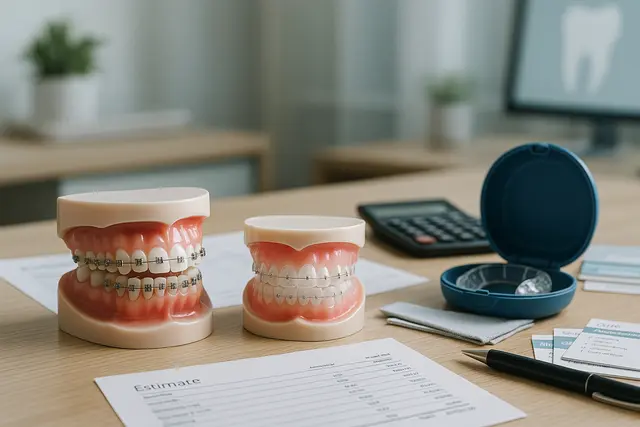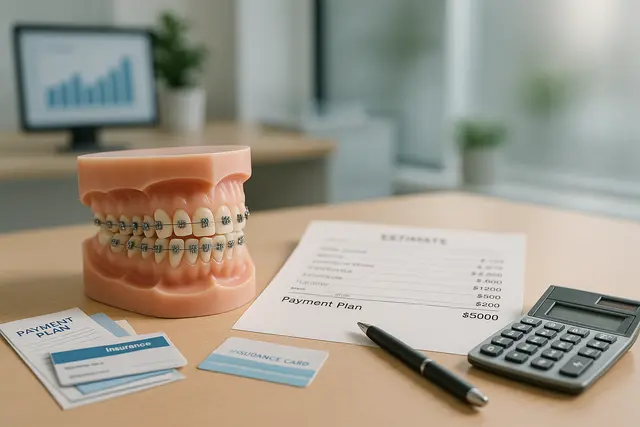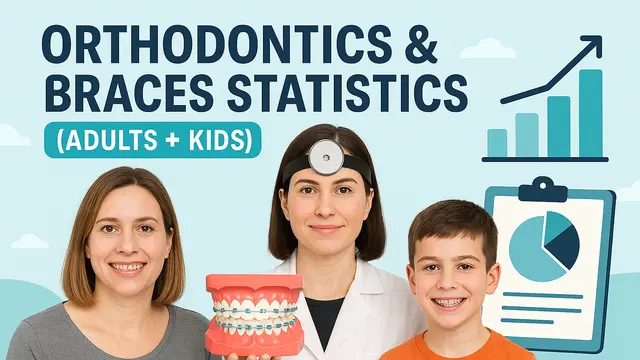Orthodontics
7 min read
Apr 03, 2025
Braces vs. Clear Aligners: Which Offers Better Results?
When it comes to straightening teeth, two options dominate the conversation: braces and clear aligners. Both have proven track records. They rely on different methods but aim for the same goal, properly aligned teeth and a functional bite. While the end result can be similar, the paths diverge in cost, comfort, visibility, and impact on daily habits.

So, your teeth aren’t exactly straight. Maybe they overlap like a badly stacked deck of cards. Maybe your bite’s off just enough to make chewing weird. Or maybe your dentist gave you that look, the one that silently screams “it’s time.” Either way, here you are, staring at the orthodontic fork in the road: braces vs. clear aligners. Which one actually delivers the results you want…without turning your daily life upside down?
Let’s break it down, no fluff, no weird jargon, just honest answers from people who get it.
Brace Yourself: What to Know About Braces
Braces have been the traditional go-to in orthodontics for decades, and honestly, they still get the job done. They’re made of metal (or sometimes ceramic if you're going for the low-key look) and involve a network of metal brackets and a metal wire that work together to move teeth into their desired position.
Braces are placed directly on the teeth and adjusted periodically to apply pressure on the teeth. That pressure is what helps straighten your teeth over time. They come in a few flavors: traditional metal braces, ceramic braces, and lingual braces (those hide behind your teeth for stealth-mode correction).
If you wear braces, there’s a bit of a lifestyle shift. You'll need to avoid certain foods (popcorn, we’re looking at you), and you’ll become best friends with your floss threader. But the flip side? Braces work on pretty much every case. Crowded teeth, serious gaps, major bite issues, you name it, braces can probably handle it.
Aligners: The Modern Alternative
Aligners are the slick, tech-savvy cousin of braces. You’ve probably heard of Invisalign, that’s one brand of clear aligners. These custom-fit trays are made of clear plastic and designed to move teeth with gentle, controlled pressure. Unlike traditional braces, aligners are removable, which means you can take them out to eat, brush and floss, or give yourself a little break (within reason, more on that later).
Aligners work in stages. Every few weeks, you’ll pop in a new set of aligners that continue nudging your teeth closer to where they should be. A complete treatment involves a full series of clear aligners designed to fit your teeth at each phase.
Here's the kicker: aligners are nearly invisible. If you're not jazzed about metal brackets gleaming every time you smile, aligners are more discreet and comfortable than braces. But, and this is important, they only work well if you actually wear your aligners 20–22 hours a day. Forgetting to wear your aligners or taking them out too often? Your teeth will know.
Clear Aligners: Worth the Hype?
Let’s talk specifically about clear aligners for a second. These things are basically dental ninjas. They’re quiet, nearly invisible, and they get the job done without drawing attention. For adults especially, clear aligners are often the top pick because, let’s face it, boardroom meetings and first dates aren’t ideal moments for metal brackets to steal the show.
Clear aligners are made of smooth plastic, so you won’t get that classic “brace face” irritation on your cheeks. They’re less likely to trap food, and you can clean your aligners easily (just keep your aligners in their case when you're not using them, and clean your aligners regularly unless you want them looking cloudy and smelling like your lunch).
But again, aligners require commitment. You need to wear your aligners consistently and take your aligners out only when necessary. Forgetting a day here and there can stretch out your orthodontic treatment or mess with your results.
Invisalign: The Clear Aligner Giant
When people say “Invisalign,” they usually mean all clear aligners, but Invisalign is just one (very big) brand. Invisalign treatment uses a series of clear plastic aligners that are custom designed using 3D imaging of your teeth.
Invisalign aligners are great for mild to moderate cases, and they’ve come a long way in being able to treat more complex issues too. With Invisalign, you also get support from your orthodontist or dentist throughout the process, which means you’re not just winging it with a box of plastic trays.
Braces and Invisalign treatment both work to straighten your teeth, but Invisalign aligners tend to feel more modern and convenient. Still, braces can offer more power for tougher jobs. It’s a little like comparing a hybrid car to a heavy-duty truck. Both get you there, just in different ways.
Metal Braces: The Classic Heavy Lifter
Now let’s give metal braces their moment. These are the OGs of orthodontic aligners. They’re durable, effective, and better than braces in complex cases. Metal braces are great for kids, teens, and adults who need serious dental realignment.
There are different types of metal braces, but they all involve brackets attached to your teeth and connected by a wire. This setup gives your orthodontist a ton of control over how your teeth move and when. And while metal braces may not win any awards for being low-profile, they absolutely win when it comes to reliability.
Metal braces may be more visible, but unlike traditional braces of the past, today’s versions are smaller and more comfortable. You can even add colorful rubber bands for a little flair (if that’s your thing).
Orthodontic Treatment: How Long Does It Take?
Orthodontic treatment takes time. Whether you choose braces or aligners, you’re looking at months or even years of commitment. The actual timeline depends on your specific case, how consistently you wear your aligners, or how regularly your braces are adjusted.
In general, aligners are less noticeable than braces, but treatment with braces can be faster for some severe corrections. Aligners are also more dependent on the patient, if you’re not wearing aligners as directed, you’re basically hitting pause on your progress.
Dental Health and Maintenance
Dental hygiene is a major factor here. With braces, it’s trickier to brush and floss around all that hardware. Patients with braces need to be diligent, or risk white spots, cavities, or gum problems. Aligners are removable, so it’s easier to brush and floss normally. Just don’t forget to clean your aligners too.
Whether you're wearing aligners or braces, you’ve got to stay on top of your dental routine. No one wants to invest months into straightening their teeth only to end up with new problems because of bad brushing.
Braces vs Aligners: Cost Talk
Ah yes, the big question: how much do braces cost compared to clear aligners?
The cost of your treatment depends on a lot, severity of your case, how long it’ll take, and what type of appliance you're using. On average, traditional metal braces are less expensive than clear aligners. But don’t assume that aligners are always pricier. In some simple cases, they’re actually very competitive, especially if your provider offers flexible payment plans.
It’s best to talk with your orthodontist about what fits your budget and your smile goals.
Clear Aligners vs Metal Braces: The Final Face-Off
Clear aligners vs metal braces, it really comes down to your lifestyle, priorities, and the complexity of your case. Aligners are sleek, nearly invisible, and make eating and cleaning a breeze. But they only work if you wear them as directed.
Braces are less flexible day-to-day but more consistent. They don’t rely on willpower, and they can tackle even the gnarliest of dental puzzles. Plus, they don’t get lost at the lunch table or left in napkins.
Both braces and aligners are effective orthodontic treatment options. Neither is “better” across the board. It’s about what’s better for you.
Braces and Clear Aligners: A Quick Comparison
Braces are made of metal or ceramic and are attached to your teeth.
Aligners are made of clear plastic and fit your teeth like a glove.
Braces are available for almost every kind of case.
Aligners are more discreet and comfortable than braces but require discipline.
Braces and invisalign both have pros and cons, talk to your provider about what fits best.
Metal or Clear: What Should You Choose?
Choosing between metal or clear comes down to how much visibility you’re okay with, how intense your orthodontic needs are, and how hands-on you want to be with your treatment.
Clear braces (ceramic) are a great compromise, less visible than metal, but still fixed in place. Lingual braces hide behind your teeth. There’s also the option of clear plastic aligners if you want something virtually invisible.
Braces Come With Confidence Too
Don’t sleep on how life-changing a straight smile can be. Whether you go with braces or aligners, the end result is what counts: better bite, easier cleaning, and that glow-up grin you’ve been waiting for.
Is One Better Than the Other?
That’s the million-dollar question. Are aligners better than braces? Do braces have advantages over braces (you’d be surprised how many types there are)? The truth is, neither wins outright.
If you’re looking for a powerful, set-it-and-forget-it option, braces are your answer. If you want flexibility and aesthetics, aligners might be the better fit. And hey, some people even do hybrid treatments, braces and aligners, depending on what phase they’re in.
Final Thought: Get a Pro Opinion
No matter how many articles you read (even really good ones like this), nothing beats a chat with a qualified provider. A pro can evaluate your bite, your bone structure, and your lifestyle to recommend the treatment that’ll get results without making your daily life miserable.
So yeah, braces and clear aligners both work. But the best one? That’s the one that fits your mouth and your life.
Need help deciding? We’re here for you, straight teeth, straight talk. Always.
What Are the Main Differences Between Braces and Clear Aligners?
Braces are fixed to your teeth and use metal wires and brackets to move them over time. Clear aligners are removable trays made of transparent plastic that gradually shift your teeth. Braces are better for complex corrections and don’t rely on patient compliance, while aligners offer more discretion and flexibility but require consistent wear to be effective.
Are Clear Aligners as Effective as Braces for All Cases?
Clear aligners can treat mild to moderate alignment issues very effectively, and technology has advanced to handle more complex cases. However, for severe crowding, bite problems, or significant shifts, braces often provide more precise control. The best option depends on your individual orthodontic needs and how disciplined you are about wearing aligners.
How Do Braces and Aligners Compare in Terms of Comfort and Maintenance?
Clear aligners are generally more comfortable since they don’t have brackets or wires that can irritate your cheeks and gums. They’re also easier to clean because they’re removable. Braces, while less comfortable at first, work continuously and don’t depend on you remembering to wear them. However, cleaning around braces requires more time and care.
Is There a Big Cost Difference Between Braces and Clear Aligners?
The cost varies depending on the complexity of your treatment and where you live, but traditional metal braces are usually more affordable. Clear aligners may cost more, especially if your case is extensive. Some simpler cases may actually be cheaper with aligners, especially if your provider offers flexible payment plans. Always ask for a full cost breakdown before choosing.
Read Next
Related Posts

Orthodontics
Retainer That Looks like Braces: Benefits for Long-Term Alignment
A retainer might not get as much attention as braces, but it plays a crucial role in maintaining your smile after orthodontic treatment. Whether you're new to retainers or curious about the type that looks like braces, understanding their purpose and benefits is key to keeping your teeth aligned for the long haul.
6 min read
Sep 15, 2025

Orthodontics
How Much Are Metal Braces? Cost Comparison With Other Options
Thinking about getting braces but overwhelmed by the cost? You’re not alone. Orthodontic treatment can be a major investment, and understanding the different price points, from metal braces to clear aligners, can help you make a smart, confident decision.
5 min read
Sep 15, 2025

Orthodontics
Orthodontics & Braces Statistics (Adults + Kids)
Orthodontics has transformed from a niche medical service for teenagers into a booming sector that spans all ages. Today, both adults and children seek orthodontic treatment to improve their smiles, fix bite issues, and boost self-confidence.
4 min read
Aug 21, 2025
Don’t have time to research every dentist around you?
See why 30k+ patients trusted us